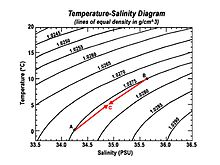Cabbeling
Cabbeling is when two separate water parcels mix to form a third which sinks below both parents. The combined water parcel is denser than the original two water parcels.
The two parent water parcels may have the same density, but they have different properties; for instance, different salinities and temperatures. Seawater almost always gets more dense if it gets either slightly colder or slightly saltier. But medium-warm, medium-salty water can be denser than both fresher, colder water and saltier, warmer water; in other words, the equation of state for seawater is monotonic, but non-linear. See diagram.
Cabbeling may also occur in fresh water, since pure water is densest at about 4 °C (39 °F). A mixture of 1 °C water and 6 °C water, for instance, might have a temperature of 4 °C, making it denser than either parent. Ice is also less dense than water, so although ice floats in warm water, meltwater sinks in warm water.
The densification of the new mixed water parcel is a result of a slight contraction upon mixing; a decrease in volume of the combined water parcel. A new water parcel that has the same mass, but is lower in volume, will be denser. Denser water sinks or downwells in the otherwise neutral surface of the water body, where the two initial water parcels originated.
